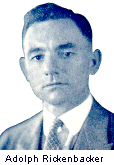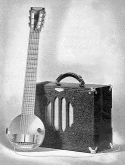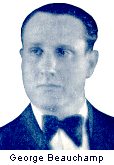In 1930 after being fired by National George Beauchamp began looking for new ways to increase the volume of the guitar. It was common knowledge by this time that passing a wire through a magnetic field produced a change in magnetic field intensity which in turn could be used to create a changing electric current in a properly coupled coil of wire. This same principal was the basis for electric motors, generators, phonograph needles, accoustical speakers, and many of the other products being developed and marketed at this time. As early as 1925 Beauchump had been experimenting by using phonograph needles to produce a single string electric guitar on a piece of two by four and believed that if a device could be developed which could "pick up" the vibrations of each individual string, and convert those vibrations into a proportional variation in electrical current, then that changing current could be amplified by one of the tube type amplifiers used typically in the PA and Radio systems of the day.
After many months of trial and error with most of the experiments conducted on his dining room table Beauchamp, along with Paul Barth developed a working "pickup" out of two horseshoe magnets and six pole pieces.The guitar strings passed through the magnets with each pole located so as to concentrate an independent magnetice field over each string. They wound the coil with the motor from Beauchamps washing machine, and according to Barth they ended up winding the coil with a sewing machine motor. A detail drawing from the original patent drawing submitted by Beauchamp is shown below.
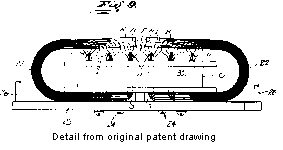
When the pickup was doing it's job Beauchamp contacted Harry Watson, who was the plant superintendent from National and a highly skilled craftsmen who using all hand tools carved the neck and body of the first working electric guitar in a few hours at Beauchamps kitchen table, they called it the "Frying Pan". A photogragh of the original device constructed by Beauchamp and Watson is shown below.
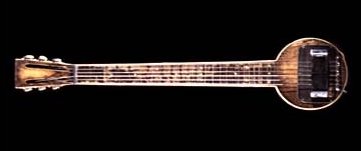
With prototype in hand Beauchamp approached Adolph Rickenbacher, Rickenbacker a cousin of WWI flying ace Eddie Rickenbacker owned a local tool and die company and had been associated with Beauchamp at National, manufacturing the metal bodies for the Resonators. Utilizing Rickenbackers influence and financle assistance they formed a company and after sevaral name changes they decided to call the instruments Rickenbackers due to the familiarity of the Rickenbacker name and difficulty in pronouncing Beauchamp ( pronounced Beechum ). They began manufacturing the "Frying Pan" which immediately became popular as a Hawaiian lap style slide guitar and set the Rickenbaker company on it's historical path of becoming the first manufacturer of electric guitars. Below are photographs of Rickenbacker and Beauchamp alongside the first fully manufactured electric guitar the "Frying Pan"
